Why do you need to include Romanian deadlifts in your fitness routine? The number one reason is that these deadlifts train your posterior chain the muscle network in your back. This helps strengthen your back significantly. A part of this exercise brings you to the posture of a bent-over row – a workout that strengthens your back. But a Romanian deadlift allows you to move a large amount of weight.
For this reason, a Romanian deadlift also helps strengthen your grip, which is interestingly one of the indicators of good overall health.
While a Romanian deadlift trains almost the same muscles and body areas that a conventional deadlift does, the Romanian version puts a little more emphasis on hamstrings and glutes.
How to Perform Romanian Deadlifts?
When performing Romanian deadlifts, keep in mind that it involves a lot stiffer legs and no squatting movement. However, it is not right to perform this workout with straight legs. You will need to soften your knees.
Here is how to perform a Romanian deadlift.
- Hold the barbell or dumbbells in front of your thighs when standing still. Now, bend your body through the hips and lower to the ground. Push your hips back during this movement.
- When lowering, make sure that your shoulder blades are drawn towards each other. Your chest should be wide.
- Lower the weight just below your knees, but do not get it too close to the ground. Now, push your hips forward and get into the starting position.
How to Maintain the Proper Form during Romanian Deadlifts
Maintaining proper form during Romanian deadlifts is imperative to ensure that you train the right muscles. Here are some form tips to help you with that.
- When lowering, your weight should stop in the middle of your shin. Lowering too far down will cause a bend in your back, and you will have to use other muscles that you do not want to work during this movement.
- Contrary to the common perception, a Romanian deadlift doesnt involve a straighter spine. You will need to curve it a little. Neutral may be the most appropriate word to describe the spine form you must maintain during this workout.
- When performing these deadlifts, ensure that your upper back is adequately engaged. Do not let the weight of the barbell draw your shoulder blades away from each other. A typical symptom of an erroneous technique in this scenario is a curved upper back.
- When standing tall, make sure that your feet are shoulder-width apart and your shoulders are drawn backward. When lowering, use your hips as a hinge. Do not bend your spine beyond the neutral position as discussed above. And push your hips backward as you continue to lower.
- The bar should remain close to your legs throughout its downward journey. Your core must be tight during this movement. Maintain your form when returning to the starting position.
Benefits of Romanian Deadlifts
Romanian deadlifts offer a myriad of benefits to Olympic weightlifters, powerlifters, and general fitness enthusiasts. This workout helps enhance your strength, speed, and overall performance in competitive sports. It also offers numerous general health and fitness benefits.
Muscular Hypertrophy
Muscular hypertrophy is the essential component of the overall enhancement of force development, power, and sports performance. With the help of Romanian deadlifts, you can strengthen your hamstrings, glutes, and lower back muscles while minimizing the risk of injury.
Olympic Weightlifting Applications
Romanian deadlifts help improve strength and power for Olympic weightlifting moves, such as clean pull, clean and jerk, and the snatch.
Enhancing Overall Deadlift Performance
The Romanian deadlift is a supportive move that helps enhance your ability to perform conventional deadlifts with a maintained form and for longer durations. This workout engages your core muscles and gives extra strength to your glutes and hamstrings, the muscles are pivotal in a conventional deadlift.
Lower Back, Hips, And Hamstring Performance
Your hips, posterior chain, and hamstrings are used in a variety of athletic movements, such as running, sprinting, and jumping. Some sports benefit from power hips extension. All these muscles and body areas are worked well during a Romanian deadlift. Not only do these deadlifts enhance mass and strength in these muscles, but they also help resist injuries in these areas.
Injury Prevention
Last but not least, Romanian deadlifts help correct hip hinging patterns, improving overall strength and performance for conventional deadlifts, cleans, and other movements involving front loading. These workouts mainly require a more rigid spine, which you can learn to maintain during a Romanian deadlift.
How Do Training Belts Help With the Romanian Deadlift?
Romanian deadlifts require a straighter spine, especially when you lower the weight. This is where you may benefit from a training belt, which wraps tightly around your waist and braces your core. As a result, you have a better chance of maintaining the correct spine posture.
Some reasons why wearing a training belt is necessary during a Romanian deadlift include the following.
- These belts help prevent injuries to your spine and other core muscles.
- With a more stable spine and core, you will be able to lift more weight.
- With a training belt wrapped around your waist, you will feel the bracing effect, which can help you overcome your physical and mental barriers.
- This belt improves your biomechanics during your moves.
- And finally, this belt will take the stress off your spine.
Speaking of training belts, GASP Training Belt is one of the best wearables you can include in your gym wear. This belt is composed of high-quality leather and is available in small, medium, and large sizes. The strength, durability, and comfort of this belt allow you to pay attention to your workout details, helping you get the most out of your moves. The 4-inch width of this belt covers a significant area of the lower back, keeping your spine stable in the right posture.












4 Comments
Comments are closed.